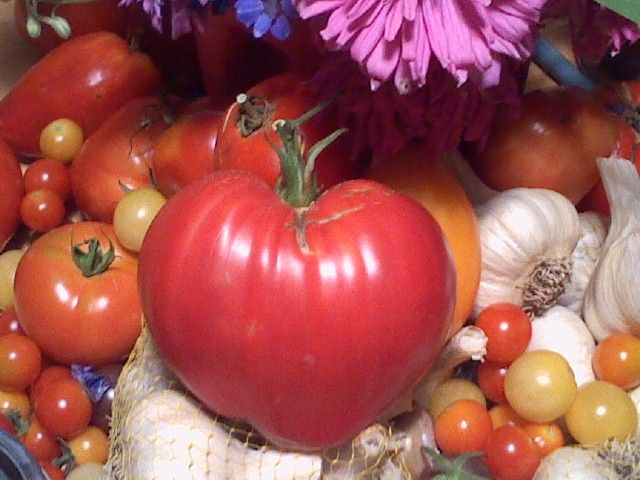Post by oxbowfarm on Jun 3, 2014 9:28:50 GMT -5
I've been playing with a lettuce cross population for a couple of years now. I highly recommend it to anyone, it is buckets of fun. A single F1 lettuce plant can give you years of fun watching the progeny segregate. The original plant appeared in a group of Black Seeded Simpson. The off-type plant was a pale pink-red blushed leaf lettuce, pretty easy to notice among the bright yellow green BSS. I saved the seed from it thinking it was a different variety that had gotten mixed into the packet. The next generation proved that it wasn't a seed contaminate but was intact an F1 hybrid plant, and that the pollen parent had been something very very red indeed. The F2 progeny give you a huge range of segregates for red vs green color and for leaf shape and plant architecture.
Here's a photo of a group of these F2s I have growing right now. The row all the way on the left is the F2 plants, I sorted the transplants for color when I was transplanting, so the green plants start at the far end of the photo and the red plants are at the end of the row at the bottom of the pic. Then they wrap around and start up the the next row till you see the bright green plants which are Black Seeded Simpson.

I've selected from these F2 populations before and I have a line of green leaf lettuce that I'm excited about. They are still segregating for frilliness of leaf and some other characteristics, I'm selecting for frilliness and good growth. Here's some F3 plants .

I'm also excited about a few red leaf lettuces that have shown up in the most recent F2 planting. Here's a closeup of one of them. The F2 plant is on the left. On the right are New Red Fire leaf lettuce, which is my go-to red leaf for market. It is a very nice red leaf, and is extremely popular with market growers here in the Northeast. I'm excited about this F2 plant because it is redder and faster growing than NRF in the same soil planted at the same time. Red sells at market, and a darker red makes a more exciting display on the table.

After looking at these lettuces and how they are segregating, I'm fairly certain that the pollen parent was a dark red summer-crisp/Batavian type lettuce. Something very like Cherokee. I'm interested in attempting to replicate this with a BSS/Cherokee cross , but I've had trouble getting lettuce crosses to take. The procedure for lettuce crossing requires you to wash the stigmas after the flower opens to remove the self pollen and make the cross with the parent pollen. That has been trickier for me to achieve than I expected. I tend to do these kinds of projects in the field very quick and dirty vs in a greenhouse env. So that may have something to do with it.
Here's a photo of a group of these F2s I have growing right now. The row all the way on the left is the F2 plants, I sorted the transplants for color when I was transplanting, so the green plants start at the far end of the photo and the red plants are at the end of the row at the bottom of the pic. Then they wrap around and start up the the next row till you see the bright green plants which are Black Seeded Simpson.

I've selected from these F2 populations before and I have a line of green leaf lettuce that I'm excited about. They are still segregating for frilliness of leaf and some other characteristics, I'm selecting for frilliness and good growth. Here's some F3 plants .

I'm also excited about a few red leaf lettuces that have shown up in the most recent F2 planting. Here's a closeup of one of them. The F2 plant is on the left. On the right are New Red Fire leaf lettuce, which is my go-to red leaf for market. It is a very nice red leaf, and is extremely popular with market growers here in the Northeast. I'm excited about this F2 plant because it is redder and faster growing than NRF in the same soil planted at the same time. Red sells at market, and a darker red makes a more exciting display on the table.

After looking at these lettuces and how they are segregating, I'm fairly certain that the pollen parent was a dark red summer-crisp/Batavian type lettuce. Something very like Cherokee. I'm interested in attempting to replicate this with a BSS/Cherokee cross , but I've had trouble getting lettuce crosses to take. The procedure for lettuce crossing requires you to wash the stigmas after the flower opens to remove the self pollen and make the cross with the parent pollen. That has been trickier for me to achieve than I expected. I tend to do these kinds of projects in the field very quick and dirty vs in a greenhouse env. So that may have something to do with it.





